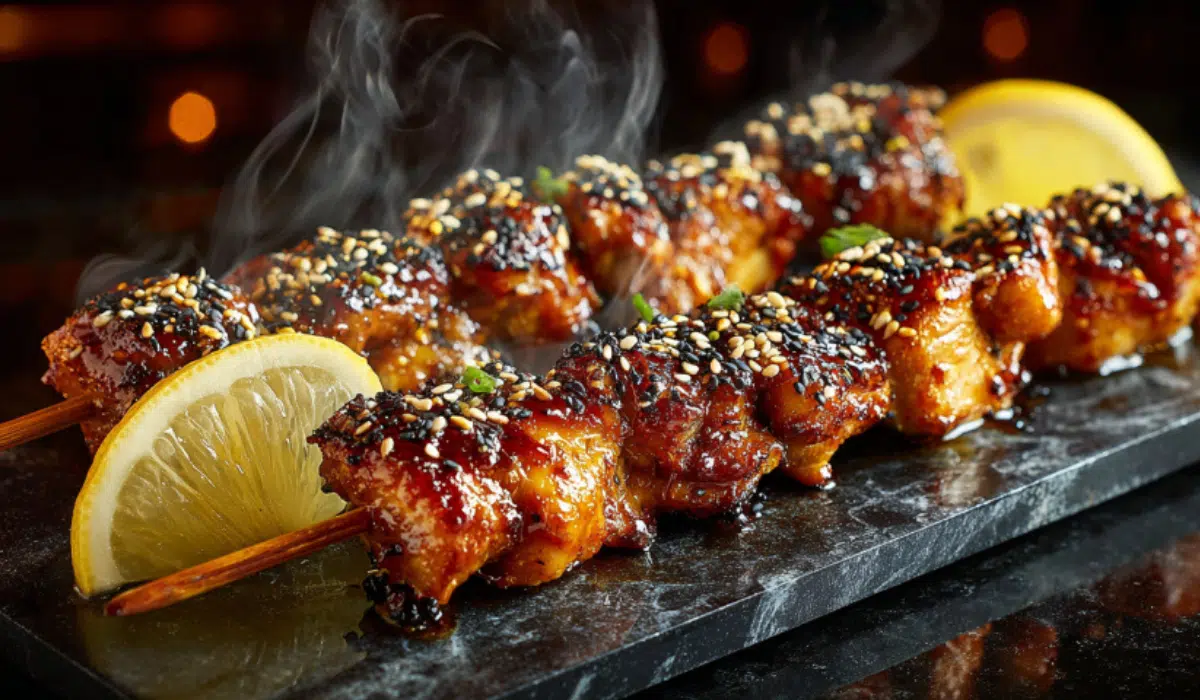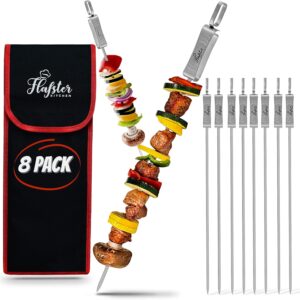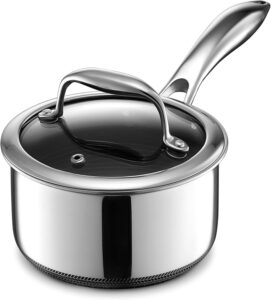Japanese Chicken Yakitori Recipe brings the smoky charm of street-side grills straight to your kitchen. Juicy chicken thighs and crisp scallions are skewered, then glazed with a glossy soy-based tare or seasoned simply with salt for shio style. Whether you’re firing up charcoal, lighting a gas grill, or sliding trays under the broiler, this recipe makes it easy to enjoy authentic yakitori at home. The balance of sweet, savory, and charred flavors turns a few simple ingredients into a dish that feels special every time.
Table of Contents
Why You’ll Love This Yakitori
- Simple ingredients, big flavor: Chicken thighs, scallions, soy, mirin, and sake create rich depth with just a few pantry basics.
- Two delicious paths: Choose tare for a glossy sweet-savory glaze or shio for pure smoky chicken flavor.
- Cook anywhere: Whether you use charcoal, a gas grill, or your oven broiler, the method adapts easily, and for another fast weeknight option try Thai Peanut Chicken Wraps.
- Perfect for sharing: Skewers make it fun and easy to serve at gatherings or as part of a casual dinner spread, especially alongside Bang Bang Chicken Sliders.
- Authentic yet approachable: With clear steps and home-friendly swaps, you’ll capture the spirit of Japanese street food without stress.
This version of yakitori gives you both authenticity and flexibility, turning a classic izakaya favorite into a dish you’ll want to repeat often.
Ingredients Needed
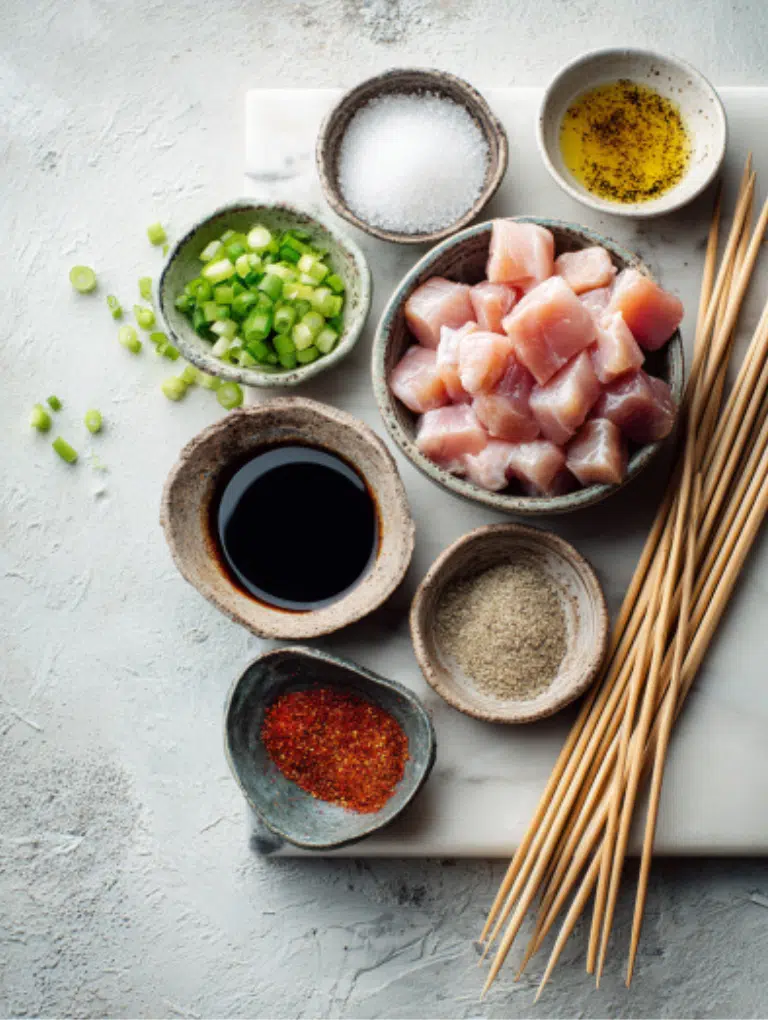
Chicken and Aromatics
- 1 lb boneless skinless chicken thighs: juicy and tender, cut into even cubes
- 2 Tokyo negi (Japanese long onions) or 9 green onions: cut into 1¼-inch pieces
Tare Sauce (for glazing)
- ½ cup soy sauce: regular or low-sodium
- ½ cup mirin: sweet rice wine for balance
- ¼ cup sake: adds depth; dry white wine can be used in a pinch
- ¼ cup water: prevents sauce from reducing too quickly
- 2 tsp brown sugar, packed: gives shine and sweetness
- Negi greens: simmered in the sauce for aroma
Shio Seasoning (salt option)
- Fine salt: sea salt or kosher salt
- Optional white pepper: subtle heat
Garnishes
- Shichimi togarashi: Japanese chili pepper blend for a spicy finish
- Lemon wedges or sesame seeds: brighten and add texture
Notes & Substitutions
- Soy sauce: Use tamari for a gluten-free option, since many sauces contain soy sauce made with wheat. Whenever possible, ask for tamari instead.
- Mirin: Substitute with equal parts rice vinegar + sugar.
- Sake: Dry white wine works, or chicken broth for non-alcoholic.
- Chicken: Breast meat can be used but dries faster adjust cooking time.
Equipment
Skewers and Prep
- Bamboo or metal skewers, tray, wire rack, brush for glazing
Heat Sources
- Charcoal grill, gas grill, oven broiler, or stovetop grill pan
How to Make Japanese Chicken Yakitori
- Soak skewers: Place bamboo skewers in water for at least 30 minutes so they don’t burn under high heat, a tip echoed by Mississippi State University Extension.
- Prep the chicken and scallions: Pat the chicken thighs dry, then cut into 1¼-inch cubes. Slice the white and light green parts of the scallions into similar lengths. Dry surfaces help the meat brown instead of steam.
- Make the tare sauce: In a saucepan, combine soy sauce, mirin, sake, water, sugar, and scallion greens. Bring to a boil, then simmer until reduced by one-third, about 30 minutes. Cool completely; it thickens as it cools. Always set aside a clean portion for basting to avoid cross-contamination, and the USDA adds that you should never reuse marinade that touched raw poultry unless you boil it first.
- Thread the skewers: Alternate chicken and scallion pieces, packing them snugly with little to no gaps. Tight skewers cook evenly and stay juicy.
- Cook with your chosen method:
- Charcoal grill: Build hot and cooler zones. Start on medium heat, turn often, and brush with tare in the last few minutes.
- Gas grill: Preheat to medium-high. Sear over direct heat, then move to indirect heat and glaze until caramelized.
- Broiler method: Place skewers on a greased rack set over a foil-lined tray. Broil for 6 minutes, brush with tare, flip, and broil 3–4 minutes more. Brush again and finish for 1–2 minutes until glossy.
- Rest and serve: Let skewers rest briefly, then serve hot with extra tare or a sprinkle of shichimi togarashi.
Pro Tips & Troubleshooting
Expert Tips
- Cut evenly: Uniform chicken and scallion pieces cook at the same rate and prevent burning.
- Dry surfaces: Patting chicken dry before skewering helps achieve golden, flavorful char.
- Glaze timing: Brush with tare only in the last few minutes of cooking to prevent the sugar from burning. Adding it late helps avoid excess browning.
- Tight skewering: Pack pieces close together so juices stay locked in and the meat stays juicy.
Common Mistakes to Avoid
- Burnt skewers: Always soak bamboo skewers before grilling or broiling.
- Dry chicken: Don’t overcook; thighs should be just cooked through with a slight char.
- Sauce contamination: Never dip brushes back into raw-contact sauce; reserve a clean portion for basting.
- Over-salting shio: Use fine salt lightly; it intensifies as the skewers cook.
Smart Shortcut
- Make tare ahead: The sauce keeps for a week in the fridge and gets better as flavors meld, so you can prep it before grilling day.
Serving, Storage & Variations
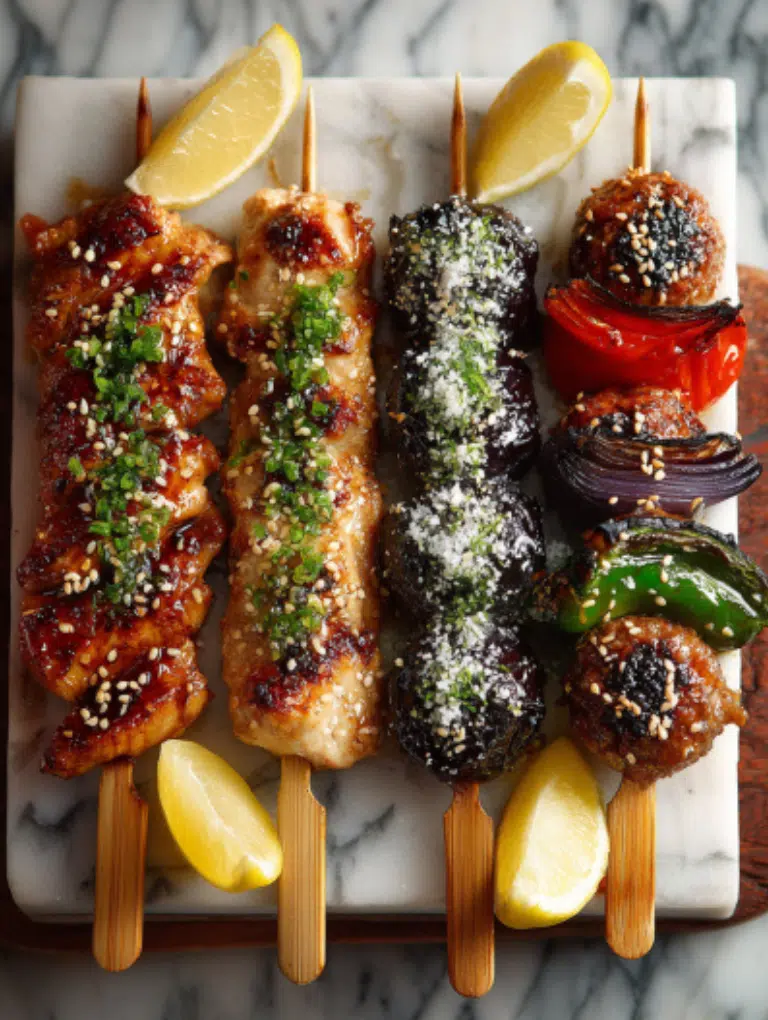
Serving Ideas
- Serve yakitori skewers over steamed rice with a drizzle of extra tare for a quick donburi bowl, or switch it up with Korean BBQ Steak Rice.
- Pair with crisp cabbage salad or Japanese pickles for a balanced spread, or add Chinese Beef and Broccoli for a fuller menu.
- Add grilled shishito peppers or mushrooms to the mix for an izakaya-style platter.
- Finish with lemon wedges or sesame seeds for brightness and crunch.
Storage and Reheating
- Refrigerator: Refrigerate leftovers in an airtight container and plan to eat them within 3 to 4 days, as USDA FSIS recommends for cooked foods, or freeze for longer storage.
- Freezer: Wrap cooked skewers tightly and freeze for up to 1 month.
- Reheating: Warm gently under the broiler or on a grill pan until heated through; avoid microwaving to keep the chicken from drying out.
Variations to Try
- Shio Yakitori: Skip the tare and season skewers with salt before grilling for a pure smoky flavor.
- Tsukune: Make chicken meatballs, skewer them, and glaze with tare.
- Veggie Skewers: Add bell peppers, king oyster mushrooms, or zucchini for a colorful mix.
- Chicken Breast Option: Leaner but cooks faster adjust cooking time and watch closely.
Nutritional Information
| Nutrient | Per Serving (1 skewer, approx.) |
|---|---|
| Calories | 150 |
| Protein | 13 g |
| Fat | 8 g |
| Carbohydrates | 6 g |
| Fiber | 0.5 g |
| Sugars | 4 g |
| Sodium | 560 mg |
Values are estimated using standard nutritional databases. They may vary depending on ingredient brands, portion sizes, and cooking method.
Nutritional highlights:
- Protein-rich from chicken thighs, making this a satisfying meal or snack, which aligns with MyFoodData figures for cooked, skinless chicken thighs.
- Balanced fats that keep the skewers juicy and flavorful.
- Moderate carbs mainly from the tare glaze, which can be reduced if desired.
Tip: If you swap soy sauce for tamari or use alternative sweeteners, use tools like Cronometer or MyFitnessPal to recalculate nutrition values for accuracy.
Conclusion
Japanese Chicken Yakitori Recipe brings the best of smoky, sweet, and savory flavors to your table with minimal fuss. Whether you choose the glossy tare glaze or the simple salt-seasoned shio version, the result is always tender chicken with irresistible char. It’s flexible enough for a weeknight meal and special enough to impress guests at a gathering, just like Creamy Sun-Dried Tomato Chicken Orzo.
If you try this recipe, please leave a star rating and share your thoughts in the comments. Pin it on Pinterest or pass it along to friends who love Japanese food. What twist did you try extra spice, veggie skewers, or shio style? We’d love to hear how you made it your own.
Frequently Asked Questions
What cut of chicken works best for yakitori at home?
Boneless chicken thighs are ideal because they stay juicy and flavorful over high heat. Breast can be used but needs closer attention to avoid drying.
How do I make yakitori without a grill?
A broiler or stovetop grill pan works well. Place skewers on a greased rack set over a tray and broil, flipping and brushing with tare until glossy.
What is the difference between tare yakitori and shio yakitori?
Tare yakitori is glazed with a sweet-savory soy-based sauce, while shio yakitori is simply seasoned with salt to highlight the natural flavor of the chicken.
Can I swap mirin or sake, and how will that change the taste?
Yes. Use rice vinegar with sugar in place of mirin or dry white wine instead of sake. The flavor may be less authentic, but still balanced and tasty.
How do I stop wooden skewers from burning or splintering?
Soak bamboo skewers in water for at least 30 minutes before grilling or broiling. For extra insurance, cover exposed ends with foil.
Can I use chicken breast instead of thighs, and what changes?
You can. Breast cooks faster, so reduce cooking time and watch carefully to keep it tender. Brush with tare toward the end to lock in moisture.
Why does my tare burn, and how do I fix it?
Tare contains sugar, so it scorches if applied too early. Always glaze in the final minutes of cooking, and reserve some sauce for serving after grilling.

